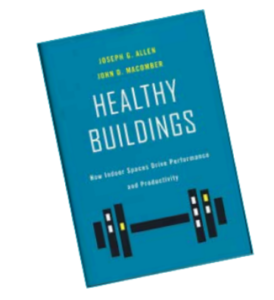Managing Moisture Damage
 Our October newsletter introduced a book titled “Healthy Buildings: How Indoor Spaces Drive Performance and Productivity.” The following article discusses another of the nine foundations of a healthy building discussed in that book.
Our October newsletter introduced a book titled “Healthy Buildings: How Indoor Spaces Drive Performance and Productivity.” The following article discusses another of the nine foundations of a healthy building discussed in that book.
MANAGING MOISTURE DAMAGE
Managing moisture in any building is one of the most significant issues a building owner faces. The question of how to keep water out of a building affects the design of the roof, windows, siding, insulation, and water or vapor barriers. Using the wrong design or material for the climate presented to the building can lead to water damage and deterioration. The wet components can support mold growth in an area not seen if that occurs, and that too will deteriorate a building’s components very quickly.
Major water events can be expensive! You can incur unexpected costs for tearing out or drying wet materials when they occur. Ceilings, walls, and floors often become saturated, and this requires the building owner to decide on drying, tearing out, remediating, and rebuilding. Certainly, that is one reason you carry insurance. Still, a large insurance claim adds people to the decision process (agents, adjusters, and insurance staff) and can delay the decision on remediation or rebuilding. That can cost the owner and tenant revenue.
We worked on a large university field house that flooded during the 2021 Texas Ice Storm. Although it was only three floors tall, the water flooded dozens of coach’s offices; physical therapy rooms; training rooms; and the locker rooms for gymnastics, volleyball, football, and several other team sports. Ultimately, hundreds of coaches, trainers, and student-athletes were kept from their training areas for many weeks after the flooding occurred.
Major water events like hurricanes and flooding can cause the most damage and disruption. However, it is the minor leaks at toilets,
vanities, kitchen sinks, or water fountains that occur more frequently. These types of leaks occur slowly and are often below surfaces or behind walls that are out of sight. Usually, these leaks are found when someone goes looking for the source of an unusual or mold-like odor.
How can you prevent the small chronic water leaks from affecting your tenant spaces?
HAVE YOUR STAFF PERIODICALLY CHECK PROBLEM AREAS. This includes the cabinets below sinks, water fountains, and restrooms on each floor.
REPLACE WATER-STAINED ACOUSTIC TILES WHEN YOU SEE THEM. While replacing the tile, your engineering staff should determine how the stain occurred and ensure the leak has stopped.
PURCHASE A MOISTURE METER FOR YOUR STAFF TO USE IN SUSPECT AREAS. A good GE Protimeter will cost about $200 but will be worth it for the amount of information it provides to your staff when a leak occurs.
STOP LEAKS WHEN YOU SEE THEM. Next, determine whether you can extract and dry the area quickly. If there is too much water for your staff to remove, call a water restoration company. Their staff is trained to promptly remove bulk water and carefully dry the wet surfaces if there is too much moisture in the materials (ceilings, walls, or floors). They
will tell you what they see, the proposed drying time, and recommend removal rather than drying in some instances.
CALL ON A PROFESSIONAL WHEN TOO MUCH WATER GETS THE BEST OF YOU. A trained water-restoration company can save you time and trouble, and they can often get your building running quicker.
If necessary, call an IAQ consultant who can inspect and document the wet surfaces using a thermal image camera. You can never have too much documentation when moisture becomes an issue in your building.
